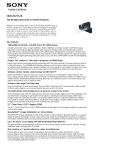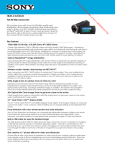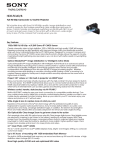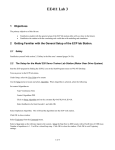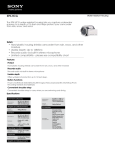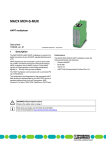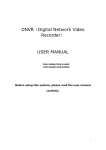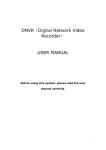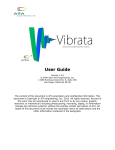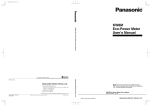Download Torsional
Transcript
Stefan B. Williams & Michael Jakuba March, 2010. Updated April 2013 by Ian Manchester AMME3500: Systems Control Lab 1- System Identification – Torsional Plant Note: The objective of this lab is to familiarize you with techniques for identifying system parameters. This lab contributes 25% towards your mark for assignment 2. This lab will be undertaken during Week 4 or 5 in the Control Systems lab in the EIE Building 522. At certain critical points these instructions ask you to discuss your results with your tutor. Your tutor is invaluable for making sure you are on the right track. To encourage you to use your tutor effectively, your tutor has been provided with a set of questions designed to stimulate discussion and assess your grasp of the lab. Your mark will be based on (1) your verbal answers to these questions and (2) a lab report prepared by your group and submitted with the second assignment. This lab should take an average student 3 hours to complete plus 1 hour of preparation. This document outlines experiments which identify the plant parameters using the ECP Systems Model 205a Torsional Plant. This material is reproduced in large part from the appropriate lab manual, which is available in the lab and on-line for you to prepare yourself for the lab. The safety portion of this manual, Section 2.3, must be read and understood by any user prior to operating this equipment. To become more familiar with these operations, it is strongly recommended that the user read Chapter 2 in its entirety prior to undertaking the operations described here. Remember here, as always, it is recommended to save data and control configuration files regularly to avoid undue work loss should a system fault occur. This lab gives a procedure for identifying the plant parameters applicable to Eq's (5.1-1 through 5.1-8 in the user manual). The approach will be to use certain fundamental properties of lightly damped second order systems to indirectly measure the inertia, spring, and damping constants of the plant by making measurements of the plant while set up in a pair of classical spring-mass configurations. Preparation a. In your own words, explain the purpose(s) of the experiment from an engineering point of view. b. Derive the equations of motion for the 1DOF torsional spring-mass system with friction damping shown below and find the transfer function. Simulate the unforced, natural response using Matlab to an initial displacement of 20o. Determine the natural frequency from the plot. Use the following parameters: i. J = 0.01 kgm2 ii. k = 2.5 Nm/rad iii. D = 0.002 N/rad/s k c. Now draw a free body diagram of the various configurations shown in Fig. 6-1.1 and used for the purposes of system identification. Assume that the bearings in the system add viscous friction. Based on your diagrams, derive the equations of motion for the system. Do the upper and lower disks interact? As part of this lab you will perturb the upper disk and observe the response. Then you will remove the weights and observe the modified response. What parameters can be identified from these two responses? You will execute the same procedure on the lower disk. Which parameters, if any, will be different? Procedure: 1. Obtain a set of masses, springs and the lab manual from your tutor. For Model 205a, clamp the center disk to put the mechanism in the configuration shown in Figure 6.1-1a using the 1/4" bolt, square nut, and clamp spacer. Only light torqueing on the bolt is necessary. 2. Secure four 500g masses on the upper and lower disks as shown in Fig. 6-1.1(a). Verify that the masses are secured per Section 2.2.2 and that each is at a center distance of 9.0 cm from the shaft center-line. 3. Open the ECP program (Start menu, ECP, ECP32). With the controller powered up, enter the Control Algorithm box via the Set-up menu and set Ts = 0.00442. Enter the Command menu, go to Trajectory and select Step, Set-up. Select Open Loop Step and input a step size of 0 (zero), a duration of 4000 ms and 1 repetition. Exit to the Background Screen by consecutively selecting OK. This puts the controller board in a mode for acquiring 4 sec of data on command but without driving the actuator. This procedure may be repeated and the duration adjusted to vary the data acquisition period. Figure 6.1-1 Configurations For Plant Identification (Model 205a shown) 4. Go to Set up Data Acquisition in the Data menu and select Encoder #1 and Encoder #3 as data to acquire and specify data sampling every 2 (two) servo cycles, i.e. every 2 Ts's. Select OK to exit. Select Zero Position from the Utility menu to zero the encoder positions. 5. Select Execute from the Command menu. Switch on the “Normal Data Sampling” checkbox. Prepare to manually displace the upper disk approximately 20 deg. Exercise caution in displacing the inertia disk; displacements beyond 40 deg may damage and possibly break the flexible drive shaft. (Displacements beyond 25 deg will trip a software limit which disables the controller indicated by "Limit Exceeded" in the Controller Status box in the Background Screen. To reset, simply reselect Execute from the Command menu.) With the upper disk displaced approximately 20 deg (≤1000 encoder counts as read on the Background Screen display) in either direction, select Run from the Execute box and release the disk approximately 1 second later. The disk will oscillate and slowly attenuate while encoder data is collected to record this response. Select OK after data is uploaded. 6. Select Set-up Plot from the Plotting menu and choose Encoder #3 position; then select Plot Data from the Plotting menu. You will see the upper disk time response. You can export data for later plotting or analysis with matlab via the “Data/Export Raw Data” menu item – note that this only saves the most recent recording. 7. Choose several consecutive cycles (say 5 to 10) in the amplitude range between 100 and 1000 counts (This is representative of oscillation amplitudes during later closed loop control maneuvers. Much smaller amplitude responses become dominated by nonlinear friction effects and do not reflect the salient system dynamics) Divide the number of cycles by the time taken to complete them being sure to take beginning and end times from the same phase of the respective harmonic cycles.1 Convert the resulting frequency in Hz to radians/sec. This damped frequency, ωd, approximates the natural frequency, ωn, according to: (6.1-1) where the "d31" subscript denotes disk #3, trial #1. Note that we will assume that the damping ratio ζd31 is small for this configuration. We will estimate the damping ratio ζd32 in step 9. (Close the graph window by clicking on the left button in the upper right hand corner of the graph. This will collapse the graph to icon form where it may later be brought back up by double-clicking on it.) 8. Remove the four masses from the third (upper) disk and repeat Steps 5 through 7 to obtain ωnd32 for the unloaded disk. If necessary, repeat Step 3 to reduce the execution (data sampling) duration. 9. Measure the reduction from the initial cycle amplitude Xo to the last cycle amplitude Xn for the n cycles measured in Step #8. Using relationships associated with the logarithmic decrement: (6.1-2) find the damping ratio ζd32 and show that for this small value the approximations of Eq's (6.1-1, -2) are valid. Record the resulting plots and estimates for the damped frequency and natural frequency in your logbook and show your tutor. 10. Repeat Steps 5 through 9 for the lower disk, disk #1. Here in Step 6 you will need to remove Encoder #3 position and add Encoder #1 position to the plot set-up. Hence obtain ωnd11 , ωnd12 and ζd12. How does this damping ratio compare with that for the upper disk? Record the results in your logbook and discuss any differences in the measured parameters with your tutor. 11. Use the following information pertaining to each mass piece to calculate the portion of each disk's inertia attributable to the four masses for the "d31" and "d11" cases. mass (incl. bolt & nut) = 500g (± 5g) dia = 5.00 cm (± 0.02 cm) Recall: Moment of Inertia for a cylinder: J = ½ mr2 Parallel Axis Theorem: J||=Jcm + md2 12. Calling this inertia Jm (i.e. that associated with the four masses combined), use the following relationships to solve for the unloaded disk inertia Jd3, and upper torsional shaft spring kd3. 1You may “zoom” the plot via Axis Scaling for more precise measurement in various areas. For an even greater precision, the data may be examined in tabular numerical form – see Export Raw Data, Section 2.1.7.3. kd3/(Jm+Jd3) = (ωnd31)2 (6.1-3) kd3/Jd3 = (ωnd32)2 (6.1-4) Find the damping coefficient cd3 by equating the first order terms in the equation form: (6.1-5) Repeat this for the lower unloaded disk inertia (this includes the reflected inertias of the motor, belt, and pulleys), spring and damping Jd1, cd1 and kd1 respectively.2 Discuss your result with your tutor. Now all dynamic parameters have been identified! Values for J1 and J2 for any configuration of masses may be found by adding the calculated inertia contribution of the masses to that of the unloaded disk3. The following is necessary to establish the hardware gain for control modeling purposes. Procedure: 13. Remove the entire upper disk, unfasten the mid-shaft disk and clamp and replace the four masses on the lower disk (only) at the 9.0 center distance following the guidelines of Step 2. Verify that the masses are secure and that the disk rotates freely. 14. In the Trajectory window deselect Unidirectional moves (i.e. enabling bidirectional inputs) select Step, Set-up. Choose Open Loop Step, and input 1.00 Volts, 500 ms, 2 reps. Execute this open loop step via the Execute menu. (For higher open loop voltages, this move may trip a software speed limit which disables the controller indicated by "Limit Exceeded" in the Controller Status box in the "desk top". Again, to reset, simply reselect Execute from the Execute menu.) Go to Set-up in the Plot Data menu and select Encoder #1 velocity for plotting. 15. Plot this data and observe four velocity profile segments with nominal shapes of: linear increase (constant acceleration), constant (zero acceleration4), linear decrease (deceleration), and constant. Obtain the acceleration, θ˙˙1e , (counts/s2) by carefully measuring the velocity difference and dividing by the time difference (500 ms) through the positive-sloped linear segment. 5,6 Repeat this for the negative-sloped segment. Calculate the average magnitude of the positive and negative accelerations for use in obtaining khw below. € 2Steps 11 and 12 may be done later, away from the laboratory, if necessary. plant configurations where a disk is used in the center location, the inertia and damping parameters may be assumed to be the same as for the upper disk. 4 Some small deceleration will exist due to friction. 5For more precise measurement you may "zoom in" on this region of the plot using Axis Scaling in the Plotting menu. 6 It is possible to read the accelerations directly by plotting Encoder #1 acceleration. This data, obtained by double numerical differentiation, is typically somewhat noisy however. The student may want to verify this by observing the acceleration plot 3In 16. Save any files or plots of interest. Exit the executive program and power down the system. Hardware Gain Calculation τ = Jθ˙˙ € Fig.6.1-2 Open loop system block diagram Consider the block diagram shown in Fig. 6.1-2. The so-called hardware gain, khw,7 of the system is comprised of the product: khw = kckaktkpkeks (6.1-6) where: kc, the DAC gain, = 10V / 32,768 DAC counts ka, the Servo Amp gain, = to be determined - approx. 2 (A/V) kt, the Servo Motor Torque constant = to be determined - approx. 0.1 (N-m/A) kp, the Drive Pulley ratio = 3 (N-m @ disk / N-m @ Motor) ke, the Encoder gain, = 16,000 pulses / 2π radians ks, the Controller Software gain, = 32 (controller counts / encoder or ref input counts)8 In Step 15, we obtained the acceleration θ˙˙1e (counts/s2) of a known inertia, J1=Jm+Jd1 with a known voltage applied at the DAC. Thus by neglecting the relatively small friction: € Applied Torque = J1 θ˙˙1 = J1 θ˙˙1e /ke (6.1-7) and we have a direct measurement of the four-term product kaktkekp. i.e.: € € 1.00V kaktkp = Applied Torque in Step 15 7It contains software gain also. This software gain, ks is used to give higher controller-internal numerical resolution and improves encoder pulse period measurement for very low rate estimates. 8The “controller counts” are the counts that are actually operated on in the control algorithm. i.e. The system input (trajectory) counts and encoder counts are multiplied by 32 prior to control law execution. (6.1-8) Use (6.1-6 through 6.1-8) to solve for khw using the specified values for kc and ks. Record this value in your log book and show your tutor. This hardware gain quantity will be important in the design of controllers to be undertaken in future labs so do not lose this value! Report Prepare a report outlining the findings of your lab. This should be prepared as a group and submitted along with your first assignment. Only one report needs to be submitted as long as you identify the apparatus you are using and all group members by name and SID. The report should include the preparation work you did prior to the lab and describe the steps taken as outlined above showing the results from each step. Include plots of the output where appropriate. In addition, address the following questions as part of your report. A. Report the measured properties and derived parameter values: Parameters Second-Order Model Values Jm Jd1 Jd3 cd1 cd3 kd1 kd3 khw B. How do your values of Jd1 and cd1 compare with Jd3 and cd3? Can you explain why they may be different? C. What were your values for ζd12 and ζd32? Are these values sufficiently small for the approximations made in steps 7 and 9 to be valid? D. Explain the importance of accurately identifying the plant parameters and hardware gain in terms of how they will affect controller design.







